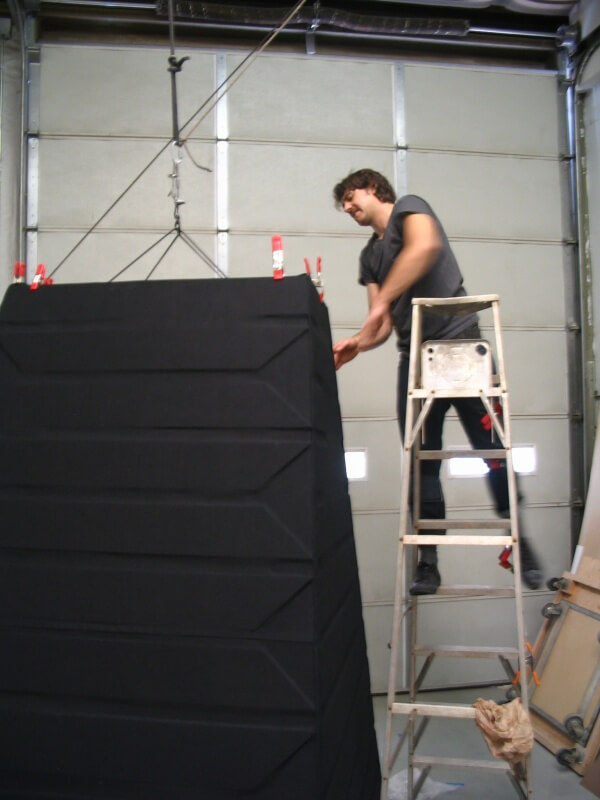By Rachel Rockford, CA ‘13
Artist Noah Manos takes an interdisciplinary approach to life.
“I think what distinguishes me from other designers and other makers is that I believe all creative formats have interconnectivity, and that combining and referencing different disciplines gives rise to new ways of thinking creatively and critically about design and making,” says Manos (CA ’98) one of the principals of a design-build architecture firm in Denver. Manos’ disciplines span his work as a photographer, filmmaker, sculptor, fabricator, designer, and developer. The CA alumnus is also co-founder with Morgan Law of a design-build firm called “PAPER AIRPLANE,” launched in 2014. The firm designs and fabricates spaces, objects and site-specific artwork.
Design-build architecture teams are those that work from concept to completion under a single contract with the project owner to design, fabricate, and manage the construction. A more traditional approach separates design and construction services.
Manos says, “Design-build proves one’s work as a designer,” because it requires an understanding of the process and materials. That fits with PAPER AIRPLANE’s core emphasis on sustainability. The firm uses Passive House standards, as a framework for creating sustainable buildings. Those standards dictate that a structure is built to use 86% less energy for heating and 46% less energy for cooling when compared to a code-compliant building. These buildings require an extremely small heating energy demand and were initially created in Europe in the 1970s. In the mid 1990s, an independent research organization was created to further the concept. The idea is used for building dwellings that are kept warm with only internal heat sources, solar energy and the minimal heating of fresh air.
Today, the low-energy building has become a worldwide trend. By 2014, the number of buildings certified with Passive House standards numbered 40,000, with thousands more low energy developments inspired by the model.
Manos says like the Passive House standards, his firm is working to “create buildings that minimize the carbon foot-prints, limit or exclude use of fossil fuels, examine embodied energy of materials, utilize renewable energy.” And they want to bring it to the forefront. “Our goal,” he says, “Is to attempt to make this mode of sustainability-focused design more part of mainstream cultural consciousness. What we pitch to clients and investors is that we are trying to make sustainability focused architecture / design / construction methodology the organic foods movement of the 21st century. We hope that by 2050, we will see a shift in the industry where sustainability is norm and not niche,” says Manos.
The company name, PAPER AIRPLANE, helps to describe the firm’s ethos: “We felt like the conceptual underpinning of the name applied to all of the different scopes that the company wanted to be involved with, specifically in that it is a really clear symbol of taking an idea into a form in a physical and simple way.”
Manos and Law met at Lewis and Clark College where they were both in the Studio Art program. Manos studied Art History and 3D Art; specifically in ceramics. After he graduated from Lewis and Clark, Manos started making surrealist avant-garde films and working for cultural institutions including the Robischon Gallery, Museum of Contemporary Art Denver, and the Denver Art Museum doing everything from exhibition production to graphic design. “That was what really pointed me in the direction of what PAPER AIRPLANE ended up becoming,” says Manos, “I developed a skill set that was kind of specific to construction even though the application was fine art.” Since its creation, PAPER AIRPLANE has designed several residential and commercial projects in Colorado.
Before his professional and college careers, Manos says his artistry and creativity were nurtured during his high school years at CA, including during his years taking Upper School photography. He remembers spending time in what used to be a traditional darkroom at CA, and says his filmmaking was an extension of that interest. For Manos, though, CA’s influence went beyond the Art Department.
The English Department is “one of the best parts of the school,” he says. “Writing is real cornerstone of our business, and the high standard of the English Department really helped me both in college and afterward as a writer.” More than anything, though, the education that Manos received at CA plays a role in his interdisciplinary philosophy. He says, “Being a principal of a company is very different from being a designer. You have to deal with the financial aspect of the company; you have to deal with the creative side, you have to deal with logistics and make strategic, critical decisions about project execution; and all the while, you have to direct the company towards its goals. The liberal arts education at CA did a good job of equipping me for all the different arenas in which I am required to work in as a co-founder of PAPER AIRPLANE.” Manos says he also carries with him the memory of life-long friends and CA teachers, including Anne Strobridge, Jim Blanas, Richard Kelly, and Dania Pettus (all now retired from CA).
Manos says he also stays in touch with CA alumni including former classmate Andrew Luecke (CA ’98), author of the just-released book, COOL: Style, Sound, and Subversion, the definitive history of youth subculture, fashion, and music, as well as Sarah Rich (CA ’98), former editor at Dwell, Smithsonian, and Medium; a co-founder of Longshot Magazine and the Foodprint Project. She is also the author of a forthcoming book about design and food.
When that group of friends from the Class of 1998 is invited back to campus for this year’s 20th reunion, they will have a lot to catch up. Reunion plans are already set for May of 2018.
